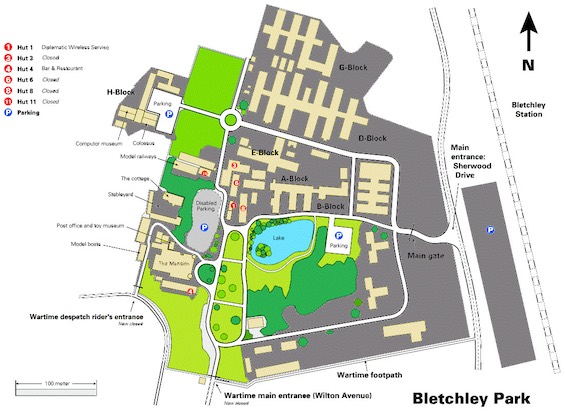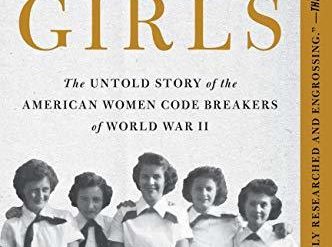
Estimated reading time: 6 minutes
Romanticized accounts of the World War II codebreakers at Bletchley Park convey the impression of a cozy community of brainy people with Oxford and Cambridge degrees laboring in isolation in the countryside. And there is some truth in this picture during the first two years of the war. But that changed. By mid-1944, as the Normandy Invasion approached, 7,500 men and women—some three-quarters of them women, as it happened—worked there. They slogged away, day after day, in a cold, sprawling campus fifty miles from London. The place is studded with makeshift huts and drab concrete and steel buildings on 58 acres. By 1945, the head count there grew to almost 9,000 working in three shifts around the clock. The crowding and primitive working conditions resembled a factory more than a military installation, much less an academic campus. Kenyon views it as the Bletchley Park intelligence factory.
A larger role in winning the war than just code-breaking
Thus, Bletchley Park was far from cozy. And in no way was the staff there isolated from the war effort. Because Bletchley Park played a larger role in the unfolding conflict than simply breaking the famous Enigma, Lorenz, and Japanese Purple ciphers and codes. British historian David Kenyon ably tells the story in Bletchley Park and D-Day.
Bletchley Park and D-Day: The Untold Story of How the Battle for Normandy Was Won by David Kenyon (2019) 295 pages ★★★★☆

“An intelligence agency in its own right”
Robert Hannigan is the former director of GCHQ, Britain’s counterpart to the US National Security Agency and the successor to Bletchley Park. In a foreword to the book, he writes: “Seldom have commanders known more about their opponents in advance of a battle than the Allies did on 6 June 1944. Much of that knowledge was acquired at Bletchley Park.” Note the emphasis on knowledge, as distinguished from raw data. That was the true product of the Bletchley Park intelligence factory.
Kenyon explains that the staff at Bletchley Park were “carrying on a wide variety of intelligence analysis functions and producing an equally wide range of product, from urgent teleprints to multi-page long-term assessment reports. This is perhaps one of the least well understood parts of Bletchley, but was undoubtedly one of the most important, lifting GC&CS from the position of merely a decryption and translation service to the status of what would be considered in more modern terms an ‘intelligence agency’ in its own right.” Of course, in many popular accounts, we may see military couriers rushing into Winston Churchill’s office bearing messages from Bletchley marked “ULTRA.” And that happened from time to time. But it’s only a small part of the true picture.
Piecing together the German order of battle
Much of Kenyon’s book revolves around the often frantic effort at Bletchley Park in the run-up to the invasion to determine the German “order of battle” in Normandy. This was the critical work to identify who would face Allied troops when they stormed the beaches. The enemy units. Their troop strength. The arms and equipment they possessed. Their commanders. And precisely where they were located. And Bletchley succeeded brilliantly at this task.
There were errors, as Kenyon concedes, but few of them. And Kenyon makes the case that this knowledge, fed to Allied commanders on the ground, was a major factor in the success on D-Day and the succeeding weeks in the Battle of Normandy. Popular accounts of that campaign often credit Operation Fortitude and Operation Double Cross—the most famous parts of the overall Anglo-American deception campaign called Operation Bodyguard—with a major share of the credit. But knowing the German order of battle was at least as important.
It is difficult to overstate the importance of that intelligence about the German strength on the ground. At the Tehran Conference late in 1943, “the president and prime minister had agreed to the invasion on the basis of quite restrictive estimates of the strength of likely opposition. In short, if Allied intelligence detected radical changes made by the Germans that had not been predicted by the planners, the invasion would be either cancelled or postponed.” As it was, German strength in Normandy came close to those limits but never crossed the line.
Overall assessment of the book
Bletchley Park and D-Day is not meant for casual reading. In fact, it reads more like a text intended for military historians and military officers. The density of detail is staggering, and I found myself skimming through much of the text (which I rarely do). But the book is worth it for anyone with an interest in understanding exactly what happened on D-Day and in the Battle of Normandy that followed—and why. David Kenyon significantly adds to that understanding with this microscopic view of the role signals and communications intelligence played there.
About the author

British archaeologist and military historian David Kenyon is the Research Historian at Bletchley Park. According to Wikipedia, “He is known for his work on presenting and interpreting World War I history at public events and in the media.” Kenyon is the author or coauthor of three books of military history, the most recent of which is Bletchley Park and D-Day.
For related reading
This book is a runner-up to the 10 top WWII books about espionage.
I’ve also reviewed three other books about the work at Bletchley Park:
- Geniuses at War: Bletchley Park, Colossus, and the Dawn of the Digital Age by David A. Price (The top-secret story of the first digital computer)
- The Emperor’s Codes: The Thrilling Story of the Allied Code Breakers Who Turned the Tide of World War II by Michael Smith (Did the British crack the World War II Japanese codes?)
- The Secret War: Spies, Ciphers, and Guerrillas, 1939-1945 by Max Hastings (A revisionist history of intelligence in World War II)
You might also enjoy:
- 10 top nonfiction books about World War II
- Books about World War II in the Pacific
- The 10 best novels about World War II
- 7 common misconceptions about World War II
- The 10 most consequential events of World War II
And you can always find my most popular reviews, and the most recent ones, on the Home Page.


























